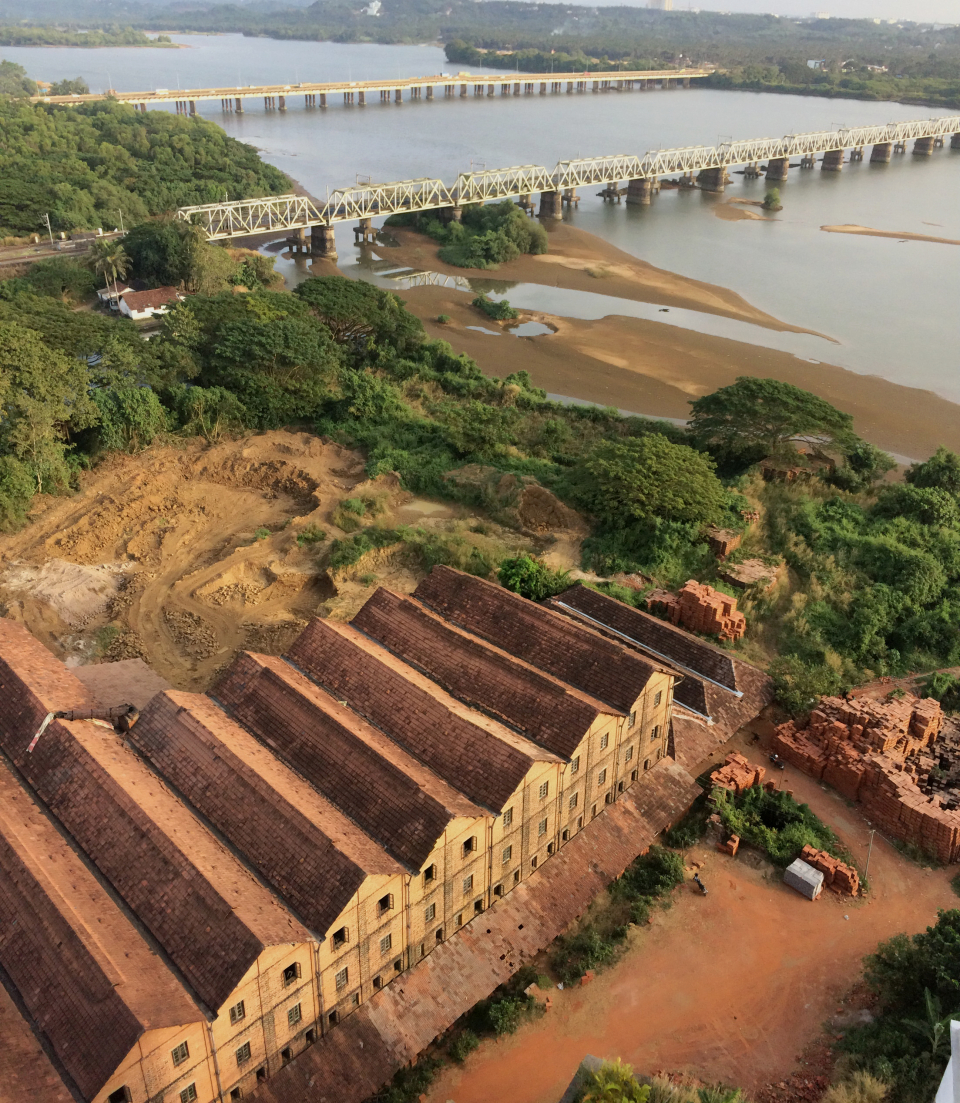Of all the Basel Mission Industries, the tile industry left the strongest material mark on the Malabar Coast. Its factory buildings and chimneys characterize riverside settlements throughout the Malabar Coast, and the use of Mangalore tiles became ubiquitous on pitched roof structures throughout the wet regions of India and beyond.
The signature product, the Mangalore Tile, defined a roof type and language of pitched roof buildings built across the subcontinent. Houses came to be known by their roofing materials as ‘Tile Houses’, a term indicating construction commonly using red oxide floors, thick brick or laterite walls and wooden-frame roofs clad with Mangalore tiles. A prior system of hierarchy in construction had restricted the masses to thatch construction, with only people or buildings of a certain status permitted to use terracotta tiles on their roofs. However, the new Mangalore tiles overrode this hierarchy, producing a tile that was used to drastically improve the roof drainage on houses of varying stature and public buildings alike.
The tile industry began in Mangalore under the supervision of Missionary George Plebst, who combined knowledge of Tile manufacturing in Germany with observations of the traditional potters’ tiles in India. Using clay from the banks of the Netravati River, Plebst redesigned the semi-circular terracotta country tiles into the ridge design ‘Mangalore Tile’ as it is still known today 1 This new tile was stronger and made for interlocking tiles, meaning that tiles no longer had to be stacked on top of each other, thus reducing the weight of the roof and eliminating the need for a heavy roof superstructure.
The new design triggered the founding of the first Basel Mission tile factory in 1865 at Jeppu, Mangalore, the success of which sparked the establishment of competing tile factories in Mangalore, including A Albuquerque & Sons (1868), Rego and Sons (1871), Cascia (1916) and Sujirkar’s Tile Works(1918). Between 1865- 1905 The Basel Mission established seven Tile Factories along the Malabar Coast, with key industrial and trading bases in Mangalore and Calicut. The tiles proved to be effective in climates with high rainfall and the factories produced tiles that were exported as far afield as East Africa, Yemen, Aden, Basra, Sumatra, British Borneo and Australia. The industry provided roof tiles and other terracotta products for building the Mission Compounds, houses, churches, educational institutes and became a staple choice for British buildings within the wet, humid regions of India and the British Empire.
During the booming periods of tile-production the factories produced a variety of products in clay ranging from common and decorative tiles for roofs, floors and ceilings to specialist tiles for roof ridges, hip terminals, ventilation and roof lighting as well as pots, coasters, plates and ornamental garden and religious items. Whilst the tiles were industrially produced from metal dies, some factories had specialist pottery studios for slip-casting or wheel-throwing household, garden and ornamental items. By 1913 the tile industry was reported to employ 2,000 workers and produce 60,000 tiles per day2
Despite the impact and success of the Mission Industries, activities came to an abrupt end as a result of the First World War. An initially mutually supportive relationship between the Basel Mission and British Empire 3 could not be sustained during the War. The German Identity of the Mission led the British Government to take control of Basel Mission Industrial activities under the provision of the Enemy Trading Act (1916). This prevented the Basel Mission Industries from operating in India and caused the commercial activity of the Mission to cease in 1920. 4 Mission properties were transferred to the Mission Trust of Madras and later to the Commonwealth Trust Limited (UK) in the 1920s. In 1977 Commonwealth Trust (India) Limited passed into Indian hands. Indian Tile production continued to operate after the exit of the Basel Mission, but was dealt an additional blow by Partition in 1947. Effects on Maritime Trade effectively wiped out the key Karachi market for tiles, providing a further step towards the decline of the industry.
- 1. (p.80, ed. Godwin Shiri, Wholeness in Christ : the legacy of the Basel Mission in India (Mangalore : Karnataka Theological Research Institute, 1985).
- 2. (p.156, Reinhard Wendt, An Indian to the Indians? On the Initial Failure and the Posthumous Success of the Missionary Ferndinand Kittel (1832-1903) (Wiesbaden: Harrassowitz Verlag, 2006).
- 3. Which included the gift to the Basel Mission of the land at Balmatta Hill from the British collector to the Missionaries (ref: George N Thomssen, Samuel Hebich of India, The Master Fisher of Men, Orissa Mission Press, Cuttack, 1905, p.26) and extensive use of Mission products in the British Empire
- 4. p. 1, 48-9, Raghaviah, Jaiprakash, Basel Mission industries in Malabar and South Canara, 1834-1914 : a study of its social and economic impact, (New Delhi : Gian Pub. House, c1990






